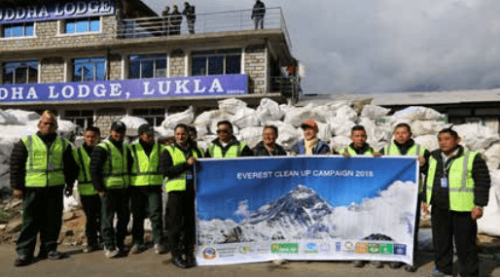
Garbage mounting up on the world's highest peak
To dub Mount Qomolangma (Mount Everest) "the world's highest garbage dump" is neither noble nor obscure. In 1963, 10 years after human beings first conquered the world's highest mountain, a Sherpa guide witnessed human waste, discarded climbing gears and other rubbish on the summit and asserted that parts of the mountain had become "the highest junkyard."
Nearly 50 years later, with mountaineering expeditions booming, more and more trekkers and climbers throng into the Himalayas, laying a long siege to Mt. Qomolangma where rubbish, such as plastic, papers, empty oxygen cylinders, cans, bottles, helicopter debris and metals, is everywhere.
In 2011, more than 30,000 trekkers and tourists visited the Sagarmatha National Park where Mt. Qomolangm lies and about 250 foreigners scaled the peak, according to the Sagarmatha Pollution Control Committee (SPCC), a local NGO, which has been working in the field of environmental conservation for about 20 years in the Sagarmatha Zone.
"More tourists mean we have to clean up more garbage. We have been seeking a solution to the pollution, which at present is not a big troublemaker, but the challenge keeps mounting," said Ang Dorjee Sherpa, chairman of the SPCC.
To control pollution, the committee has worked out strict rules under which all the garbage produced by mountaineering expeditions should be classified into three categories at base camps and each one gets its proper place.
For example, category "b" refers to non-disposables, including cans, bottles, plastics, etc. Garbage of this category must be taken back to Nepali capital Kathmandu after recording the exact weight. Garbage such as oxygen bottles and batteries belong to category "c", which must be taken back to the country of origin by expedition teams.
The clean-up expeditions by yaks and porters bring down thousands of tons of trash collected from camps and trekking trails (including the path to the top of the Mt. Qomolangma) every year. Their work is a difficult and dangerous endeavor.
Why do mountaineers leave refuse? Professional climbers said above a certain altitude, it is cloud-cuckoo-land for exhausted climbers, who have already devoted all their strength after climbing up and coming down safely to take the heavy climbing gears such as empty oxygen cylinders and tents with them.
Waste on the upper reaches of Qomolangma, like a Gordian knot, has been creating problems not only for climbers but also for residents in the region.
Done, a former porter who changed his profession to tour guide six years ago, told Xinhua last week in Namche Bazaar, the gateway to Qomolangma, that locals dare not to drink snow water directly, fearing that garbage and corpses of climbers, buried under the snow in the past and now coming to the surface due to global warming, have polluted the snow water.
(This article was released by Xinhua on June 6, 2012.)


